Shortness of breath is mostly caused by a disorder of the autonomic nervous system due to anxiety and stress. Traditional Chinese Medicine (TCM) believes that your breath becomes short or it becomes difficult to breathe when there is decreased blood flow in your respiratory muscles. Therefore, it takes stimulating the acupressure points for shortness of breath to improve the blood flow in your respiratory muscles to stop shortness of breath.
What Is Shortness of Breath?
Shortness of breath is also called dyspnea, and it is a medical condition whereby the chest tightens up, you become hungry for air, breathing gets difficult, and it’s as if you’re suffocating. You mostly get this feeling of shortness of breath when you do strenuous activities like exercise or when you become obese. So, shortness of breath can occur in a healthy person, and it is not entirely bad.
However, where it becomes bad is when it comes on suddenly without involvement in any strenuous activity and becomes severe. At this point, shortness of breath has become a medical problem that you would need to treat with acupressure points for better breathing.
What Are The Causes Of Shortness Of Breath?

In Traditional Chinese Medicine, Shortness of breath is a result of any of the following:
- Lung problem
- Heart Problem
- Disorder of the autonomic nervous system caused by stress and anxiety.
In this article, we will focus on the shortness of breath caused by the disorder of the autonomic nervous system as a result of stress and anxiety. Anxiety or panic attack, whether it is acute and based on a situation or chronic, can be responsible for shortness of breath. Anxiety causes an imbalance in the autonomic nervous system.
You need the autonomic nervous system to be balanced and fully functional because its role is to regulate blood flow by controlling the circulatory system, that is, the heart and blood vessels. When the autonomic nervous system becomes unbalanced, there will be a decrease in blood flow which also happens to be a symptom of breathing difficulty.
To breathe, you need the respiratory muscles to contract. These respiratory muscles are made up of the Diaphragm, Intercostal muscles, Sternocleidomastoid muscle, scalene muscle, Rectus abdominis, Oblique muscle, and Transversus abdominis. When there is reduced blood flow to these respiratory muscles, it becomes difficult for them to contract, hence causing difficulty in breathing.
Now that you have seen how the respiratory muscles necessary for breathing are tied to the autonomic nervous system that regulates the flow of blood to these muscles, it is important to avoid anxiety or emotional distress, which can lead to an imbalance of the autonomic nervous system. You can try acupressure for anxiety if you are always having anxiety or panic attacks.
Can Acupuncture Help Shortness Of Breath?
Yes, acupuncture can help with shortness of breath caused by anxiety. Anxiety disorders are not new or strange; they are, in fact, some of the most common psychiatric illnesses, and acupuncture treatment for shortness of breath is one of the best ways to treat it. It is used widely in clinics without any side effects, and there is sufficient research to back this up.
One such research conducted in 2014 tested for the effectiveness of scalp acupuncture treatment protocol for anxiety disorders. The treatment was tested in two cases – one was with a 70-year-old male who had a general anxiety disorder (GAD) and panic attacks at night, and the other was with a 35-year-old male who had posttraumatic stress disorder (PTSD) from his time of serving as a Combat Medic in the Iraq Combat field to provide frontline trauma care. In both cases, scalp acupuncture treatment was administered on two stimulation areas – the area between Yintang (M-HN-3) and Shangxing (DU-23) and Shenting (DU-24), and the area between Taiyang (M-HN-9) and Tianchong (GB-9) and Shuaigu (GB-8).
In the first case, the patient received scalp acupuncture treatment once a week for 45 minutes for four weeks. At the end of the treatment period, the patient stopped having panic attacks. In the second case, the patient was administered scalp acupuncture treatment in addition to body acupuncture to manage pain, as the patient experienced other symptoms like chest pain, back pain, and joint pain. He received treatment for 30 minutes every week, and by the end of the second week, the patient felt less anxious, and his sleep was improved. After 6 weeks, the patient completely recovered from PTSD. These two cases go a long way to show that acupuncture is an effective treatment for shortness of breath caused by anxiety and stress.
Acupressure Points For Shortness Of Breath
Now that we have seen how effective acupuncture for shortness of breath is. Let’s proceed to discuss the pressure points to stimulate once you notice that you are short of breath.
Acupoint: HT-7 (Other Names: Heart-7/Shen Men/Spirit Gate)
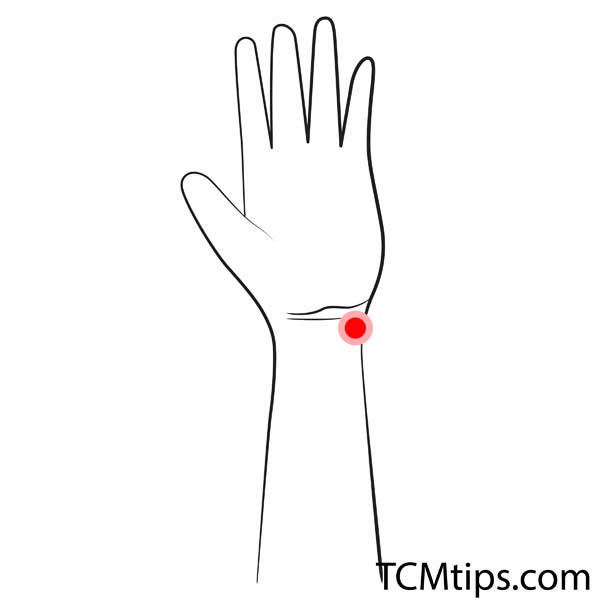
The first of the acupressure points for shortness of breath that we will be discussing is acupoint HT-7. This heart meridian pressure point for shortness of breath is called Shenmen in Chinese, which means Spirit Gate, and it is located in the hand. You’ll find it on the wrist crease, at the tendon called flexor carpi ulnaris which is at the pinky finger end of the wrist crease.
In TCM, the function of HT-7 is to calm the Shen and regulate the blood and Qi of the heart. Hence, it improves cardiopulmonary function and aids breathing. HT-7 is also notable as an acupoint for emotional issues such as anxiety and worry.
Based on its function and location, Shenmen is used clinically to treat cardiac pain, heart palpitations arising from fights, chest pain, insomnia, and amnesia. It also forms part of the acupressure points for speech development.
Acupoint: PC-4 (Other Names: Pericardium-4/Xi Men/Xi-Cleft Gate)
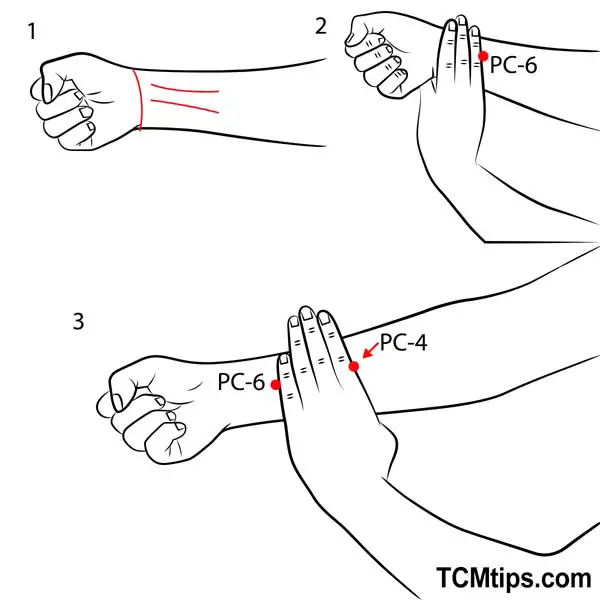
The next acupressure for shortness of breath that you should know is PC-4, also called Ximen in Chinese. This Pericardium Meridian is also located on the hand. You’ll find it just at the center of the line that connects the center of the wrist crease to the center of the elbow crease. It is six-finger-width from the center of the wrist crease.
Just like HT-7, PC-4 is also responsible for improving cardiopulmonary function and aiding breathing. It cools the blood, aids the movement of blood, removes stagnant blood, and calms the Shen.
Based on these functions, PC-4 serves as one of the acupressure points for atrial fibrillation. It is also used clinically to treat cardiac pain, epilepsy, heart palpitation, and hematemesis.
Acupoint: Ren-17 (Other Names: The Conception Vessel-17/Shan Zhong/Middle of the Chest)
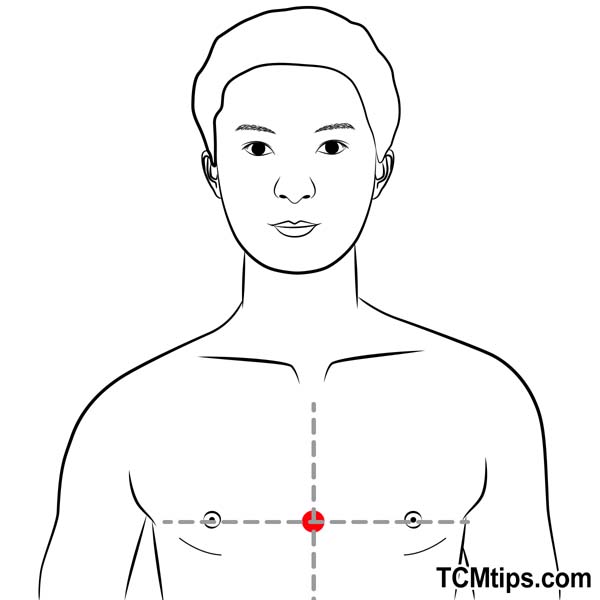
Ren-17, Tanzhong, or Chest Center is the next of the acupressure points for shortness of breath that you should pay close attention to. It is located on the chest. You’ll find it in the middle of your chest, on the same level as the fourth intercostal space. It is at the middle of the line that connects the two nipples.
TCM regards this acupoint to be very effective for Qi as it is located at the converging point of Qi. Hence, it aids in opening the chest, regulates the Lung Qi, subdues rebellious lung Qi, and benefits the breasts.
This acupressure point for the lungs is effective in treating malaise, shortness of breath, and cold that is as a result of Qi deficiency. It also treats emotional instability from stagnant Qi as well as asthma and insufficient lactation. It is one of the acupressure points for fluid around the heart.
Acupoint: GV-23 (Other Names: The Governing Vessel-23/Shang Xing/Upper Star)
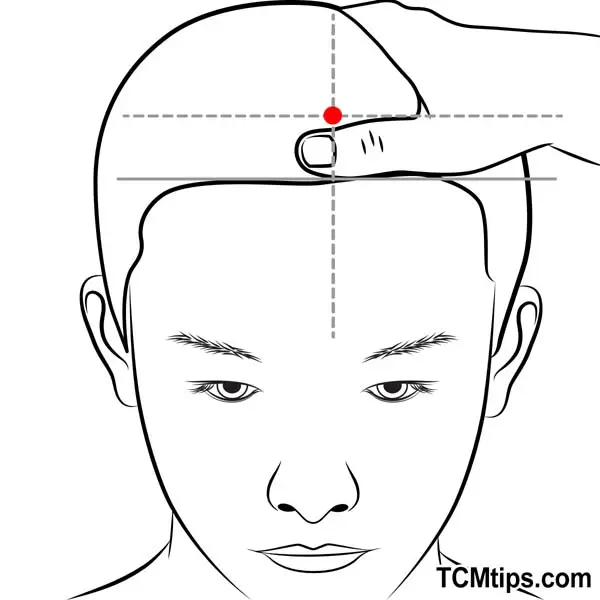
Governor Vessel 23 is another of the acupuncture points for shortness of breath that you should massage when you have anxiety. This acupoint also called Shangxing in Chinese, is located on the head. You’ll find it in the midline of the head very close to your anterior hairline, about half a finger-width from the middle of your hairline, as seen in the picture below.
Based on its location, GV-23 is considered in TCM as a dispeller of wind and an opener of the nose. It works excellently to settle anxiety and calm the spirit. This is why it is one of the acupuncture points for relaxation. It is also used to treat headaches, eye pain, and manic psychosis.
Acupoint: GV-24 (Other Names: The Governing Vessel-24/Shen Ting/Spirit Courtyard)
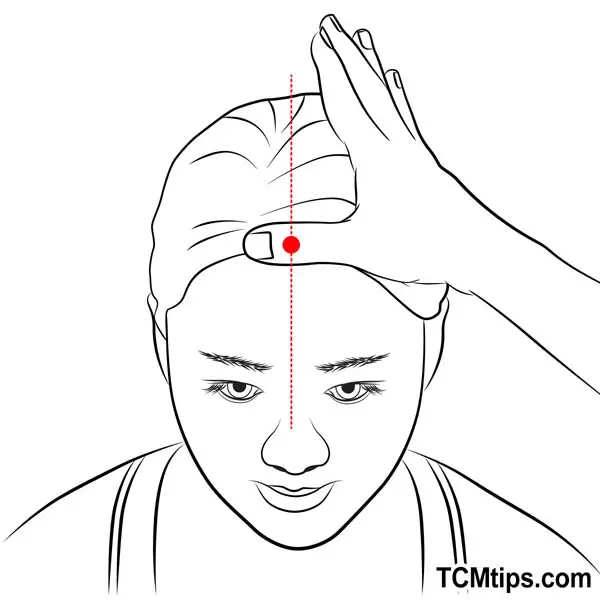
The last pressure point for shortness of breath on our list is Governor Vessel 24 or Shenting, as it is referred to in Chinese. Like, GV-23, GV-24 is also located on the head and on the same path as GV-23. However, you’ll find it six-finger-width away from the middle of your head or GV-20 and towards your hairline.
Again, just like GV-23, GV-24 works excellently to settle anxiety and calm the spirit. It functions as a dispeller of wind and an opener of the nose. It is one of the popular acupoints to use to calm and lift the mind, which is why it serves as acupressure for dementia.
Clinically, it is used to treat anxiety, palpitations, fright, insomnia, and vertigo.
Conclusion
Shortness of breath is mostly caused by an imbalance of the autonomic nervous system, which is usually a result of anxiety and stress. When this happens, blood flow to the respiratory muscles that make breathing possible becomes restricted. You need to massage the following pressure points for shortness of breath to remedy the situation:
- Acupoint HT-7 and PC-4 assist in improving cardiopulmonary function and breathing;
- Ren 17 resolves shortness of breath as a result of Qi deficiency;
- GV-23 and GV-24 stop anxiety and calm the spirit.

Try our Anti-Aging Gua Sha Tool designed to bring out your skin’s natural glow.
Best Gua Sha Product- Anti-Aging: The tool is designed to target 11 specific aging signs such as wrinkles and sagging skin. By following the 7-step routine, users can improve skin firmness and reduce fine lines naturally.
- Enhances Skincare Routine: It works effectively with serums and lotions, boosting absorption and efficacy of skincare products.
- Visible Skin Improvement: Users can expect a smoother complexion, reduced puffiness, and a more youthful appearance.
 P. Sze
P. Sze 

















